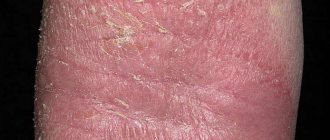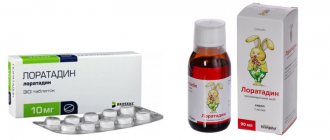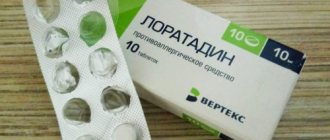Release form and composition
Dosage form - tablets: oval, white, on one side there is a dividing line and engravings “L” and “10” on both sides of the line (7 pcs. in blisters, 1 blister in a cardboard pack; 10 pcs. in blisters, in a cardboard box 1 or 3 blisters and instructions for use of Loratadine-Tev).
Composition of 1 tablet:
- active substance: loratadine – 10 mg;
- auxiliary components: corn starch, magnesium stearate, pregelatinized starch, lactose monohydrate.
Pharmacological properties
Pharmacodynamics
The active substance of Loratadine-Teva, loratadine, is a selective blocker (antagonist) of peripheral H1-histamine receptors. It has antiallergic, antipruritic and antiexudative properties. The mechanism of action of the drug is due to its ability to inhibit mast cell degranulation, block secondary inflammatory mediators (prostaglandins and leukotrienes), reduce the expression of cytokines and adhesion molecules.
Loratadine has weak affinity for muscarinic and alpha-adrenergic receptors. Does not bind to H2-histamine receptors. Does not inhibit norepinephrine uptake. Does not have a significant effect on heart rhythm and cardiovascular function.
The drug does not penetrate the blood-brain barrier. Does not affect the central nervous system. It has virtually no sedative or anticholinergic effect. Has no incompatibility with food, does not enhance the effects of alcohol. Not addictive.
Pharmacokinetics
Once in the gastrointestinal tract after oral administration, loratadine is well absorbed. Characterized by a first-pass effect through the liver. Due to biotransformation, a pharmacologically active metabolite, descarboethoxyloratadine, is formed.
With normal functioning of the liver and kidneys, the maximum plasma concentration of loratadine is achieved within 1.3 hours, descarboethoxyloratadine - 2.5 hours.
Half-life (T½): loratadine - about 8 hours, descarboethoxyloratadine - about 28 hours.
Equilibrium plasma concentrations (Cmax) of the active substance Loratadine-Teva and its main metabolite are achieved by the 5th day of treatment.
The binding of loratadine to plasma proteins is 97–99%, and that of descarboethoxyloratadine is 73–76%.
The volume of distribution (Vd) of loratadine is 119 l/kg.
The area under the concentration-time curve (AUC) of loratadine and its main metabolite depends on the dose of the drug taken. Simultaneous food intake has a slight effect on the pharmacokinetics of the drug, however, the time to reach Cmax slows down by 1 hour.
Loratadine and descarboethoxyloratadine pass into breast milk, creating concentrations similar to those found in plasma.
Loratadine is metabolized in the liver with the participation of isoenzymes of the cytochrome P450 system (to a greater extent - CYP3A4, to a lesser extent - CYP2D6).
After 10 days, about 80% of loratadine is excreted from the body in the form of metabolites by the kidneys and through the intestines (40% and 42%, respectively).
In elderly patients, the Cmax and AUC of loratadine and descarboethoxyloratadine increase by 50%, and their T½ averages 18 hours.
In severe chronic renal failure (creatinine clearance <30 ml/min), the Cmax and AUC of loratadine and its active metabolite increase, but the average T½ does not change. At the same time, the excretion of loratadine does not differ significantly from that in healthy volunteers. Hemodialysis does not affect the pharmacokinetics of the drug in patients with chronic renal failure.
In patients with alcoholic liver damage, the Cmax and AUC of loratadine are doubled, and the same indicators for descarboethoxyloratadine do not differ significantly from those in patients with normal liver function. T½ of loratadine and its metabolite averages 24 hours and 37 hours, respectively, these indicators increase in proportion to the severity of liver failure.
Teva for allergies: composition, indications, instructions, reviews
The Teva company produces more than 1,400 drugs and is distributed in all European countries and in Russia. Specialization – production of drugs – generics, i.e. analogues of original drugs with the same composition, but without patent protection, which can significantly reduce the cost of drugs.
The range of allergy medications includes:
- Derzloratadine – Teva.
- Loratadine – Teva.
- Cetirizine – Teva.
- Levocetirizine-Teva.
- Alpha-D3-Teva.
All of these medications are among the most commonly used medications for allergic reactions worldwide and are available in 48 countries and are available over-the-counter.
Despite this, before use you should consult your doctor to ensure the correct selection of the medicine and its release form. For rhinitis, sprays and drops are most effective, for dermatitis, ointments and tablet forms.
Desloratadine – Teva
The main substance is desloratadine . The drug belongs to the third generation antihistamines, blocking histamine receptors in the human body.
Indications for use:
- Contact dermatitis.
- Seasonal and year-round rhinitis.
- Irritation and itching;
- Idiopathic urticaria.
- Insect bites.
Available in coated tablets, 5 mg is approved for use by children under 1 year, ¼ portion per day. Use for adults – 1 tablet per day. Side effects: increased allergies, nausea, vomiting, drowsiness, dizziness. Pregnant and breastfeeding mothers are contraindicated for use.
Analogues: "Erius"; "Desal"; "Desloratadine."
Loratadine – Teva
The active ingredient is loratadine . It is a representative of the second generation and has a more pronounced side effect - drowsiness, compared to Desloratadine, which nevertheless does not reduce its effectiveness.
Indications:
- Seasonal rhinitis.
- Hives.
- Allergic conjunctivitis and lacrimation.
Release form: film-coated tablets, 10 mg each. Children three years of age and younger are prohibited from taking it; up to 12 years of age, half a tablet for 24 hours; adults, a whole tablet. Contraindicated for pregnant and lactating women.
Analogues: “Claritin”; "Loratadine"; "Loragexal".
Cetirizin-Teva
It is the most popular antiallergic agent in the manufacturer’s line. The mechanism of action is associated with antagonism of histamine, the main mediator that causes allergies.
Used for:
- Tearing.
- Allergic rhinitis.
- Hives.
- Allergic attacks.
The main advantage of the drug is that it removes the irritant from the body, stopping the entire allergy process, rather than stopping the symptoms. Available in the form of film-coated tablets of 10 mg. Used from 6 years of age, half a tablet per day. Adults and children over 12 years old, one each. Contraindicated for pregnant and lactating women.
Analogues: "Zirtek"; "Zodak"; "Cetrin".
Levocetirizine -Teva
Belongs to the second generation with the active substance devocetirazine hydrochloride. Quickly and permanently eliminates allergy symptoms and is less likely to cause drowsiness than representatives of the same generation.
Indications:
- Dermatitis of various etiologies.
- Chronic urticaria.
- Chronic rhinitis.
- Conjunctivitis.
Film-coated tablets (5 mg) are contraindicated in children under 6 years of age, pregnant and lactating women. Dosage regimen: 1 tablet 1 time per day.
During seasonal allergies, the drug can be used every day without fear of side effects such as drowsiness and lethargy, which will allow you to remain productive and use your car.
Analogues: "Glenset"; "Zodak"; "Allerset".
Alpha D3-Teva
Alfacalcidol - the active substance - eliminates the imbalance of calcium and phosphorus in the body by strengthening the walls of blood vessels, which inhibits the penetration of the allergen into the bloodstream and eliminates allergy symptoms. Refers not only to the drugs of choice for allergies, but also to adjuncts to the main therapy.
Indications for use:
- Any manifestations of allergic processes.
Available in capsules of 0.25 mcg. Prescribed to pregnant women as prescribed by a doctor and under supervision. Contraindicated for children under three years of age. Therapy begins with 1 mcg per day.
Analog: "Alfadol".
Before using any of the drugs in the line, it is recommended to consult a specialist about the advisability of prescribing it.
It is important to remember that addiction to allergic drugs gradually develops, due to which the effect of the drug is reduced.
It is recommended to change the drug once a month to another (an excellent active ingredient), which will avoid a decrease in the effect. You can alternate two drugs during the course, correctly replacing them, which only a doctor can do.
Consumer Reviews
- Oksana, 56 years old, Novorossiysk . I learned about Teva’s drugs from an advertisement on TV. I decided to buy Loratadine prescribed by a doctor from this company - and was not disappointed. Excellent value for money and quality.
- Oleg, 33 years old, Moscow . I was faced with itching on my hands, but I didn’t know what medicine to use in this situation. The pharmacist at the pharmacy recommended an ointment for. I was amazed at the rapid relief of itching and all allergy symptoms. Now I only use products from this company.
- Marina, 17 years old, Smolensk . With the onset of autumn, my pollen allergy worsens - it is my eyes that suffer, they begin to water and itch. I tried a lot of remedies, but Gikomycin-Teva drops helped the most.
- Kirill, 48 years old, Kiev . I have been suffering from allergies for 10 years and during all this time I have bought a variety of medications at different prices, but I chose the manufacturer Teva, since this company has the best price on the market for allergy medications.
- Igor, 31 years old, St. Petersburg . I use the drug "Alpha D3 - Teva" at the first symptoms of an allergy, as an aid to normalize calcium balance.
Source: https://allergiyas.ru/teva-ot-allergii-sostav-pokazaniya-instrukciya-otzyvy/
Loratadin-Teva, instructions for use: method and dosage
Loratadine-Teva tablets should be taken orally, before meals.
Recommended dosage:
- children 3–12 years old weighing less than 30 kg – 5 mg 1 time per day;
- children 3–12 years old weighing more than 30 kg – 10 mg 1 time per day;
- children over 12 years old (with body weight more than 30 kg) and adults - 10 mg 1 time per day.
The duration of the therapeutic course is determined individually depending on the duration of the symptoms of the disease. If after 3 days of regular use of Loratadine-Teva there is no improvement in the condition, further use of the drug is considered inappropriate.
Patients with severe chronic renal failure and severe liver failure are prescribed 5 mg 1 time per day every day or 10 mg 1 time per day every other day.
Alpha D3-Teva
Alfacalcidol - the active substance - eliminates the imbalance of calcium and phosphorus in the body by strengthening the walls of blood vessels, which inhibits the penetration of the allergen into the bloodstream and eliminates allergy symptoms. Refers not only to the drugs of choice for allergies, but also to adjuncts to the main therapy.
Indications for use:
- Any manifestations of allergic processes.
Available in capsules of 0.25 mcg. Prescribed to pregnant women as prescribed by a doctor and under supervision. Contraindicated for children under three years of age. Therapy begins with 1 mcg per day.
Analog: "Alfadol".
Teva's drugs are made in accordance with GMP standards in compliance with all norms and requirements of technological production, which ensures high quality products. However, the prices for the range of all products are lower than many manufacturers of brand name drugs of the same quality.
Before using any of the drugs in the line, it is recommended to consult a specialist about the advisability of prescribing it. It is important to remember that addiction to allergic drugs gradually develops, due to which the effect of the drug is reduced. It is recommended to change the drug once a month to another (an excellent active ingredient), which will avoid a decrease in the effect. You can alternate two drugs during the course, correctly replacing them, which only a doctor can do.
Side effects
- from the nervous system: often (from ≥ 1% to < 10%) – headache, nervousness; uncommon (from ≥ 0.1% to < 1%) – insomnia, drowsiness; rarely (from ≥ 0.01% to < 0.1%) – dizziness; in children – headache, sedation, increased nervous excitability;
- from the cardiovascular system: rarely - palpitations, tachycardia;
- from the digestive system: infrequently – increased appetite; rarely - dry mouth, nausea, liver dysfunction, gastritis;
- from the skin and subcutaneous tissues: rarely – alopecia;
- allergic reactions: rarely - skin rashes, anaphylaxis;
- other: infrequently – feeling of fatigue.
Overdose
An overdose of Loratadine-Tev is manifested by the following symptoms: drowsiness, headache, tachycardia. In children weighing less than 30 kg, after taking the drug at a dose of more than 10 mg, extrapyramidal disorders and palpitations were recorded.
After taking an excessive dose, it is recommended to do a gastric lavage and take activated charcoal. Children use a 0.9% sodium chloride solution for rinsing; adults can use water. To quickly remove loratadine from the gastrointestinal tract, enterosorbents and saline laxative solutions are prescribed. Hemodialysis and peritoneal dialysis are ineffective. Next, symptomatic and supportive therapy is carried out.
special instructions
During therapy, you should carefully maintain oral hygiene, since loratadine can cause dry mouth, which can lead to the development of caries.
Antihistamines can reduce and even hide positive skin reactions. In this regard, Loratadin-Teva should be discontinued no later than 48 hours before skin allergy tests.
Impact on the ability to drive vehicles and complex mechanisms
Loratadine-Teva in some cases causes disturbances in the central nervous system (dizziness, drowsiness), so patients are advised to exercise caution when performing potentially hazardous activities, including driving.
Loratadine is a drug from group H1
The main properties of this medicine, available in tablet form, can be described as follows:
- antipruritic;
- antiallergic;
- sedative.
Reviews about Loratadine are almost always positive. The drug is truly universal and is prescribed for symptoms of hypersensitivity such as:
- rhinitis;
- atopic and contact dermatitis;
- allergy of unspecified type;
- idiopathic urticaria;
- severe itching rash.
Once in the body, the drug immediately stops the activity of histamine receptors. This effect lasts throughout the day, thanks to which the victim can calmly go about his business and lead a full life. Loratadine is taken as follows:
- children over the age of twelve and adults take one tablet once a day (preferably with food, as the medication will be absorbed faster);
- Children from two years of age to twelve years of age take half a tablet once a day (for very young children it is better to take a suspension instead of a tablet form).
Do you like to relax?
The absence of significant contraindications and side effects are additional advantages of Loratadine. By the way, its price is also pleasing, since it does not exceed 150 rubles for a package of ten tablets.










